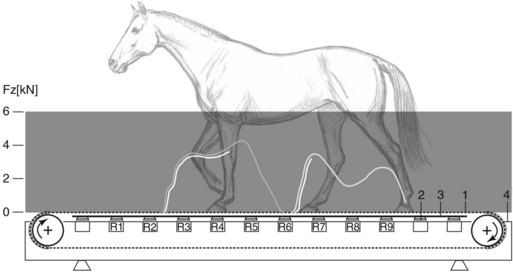Chapter 22 Gait Analysis for the Quantification of Lameness
Kinetics
A force-measuring equine treadmill is a unique piece of equipment consisting of piezoelectric load-sensitive sensors in a treadmill platform (Figure 22-1).15,16 The only working system in regular use is at the University of Zurich in Switzerland. The force-measuring equine treadmill is exceptional for detecting small changes in lameness between treatments because of its ability to collect data from multiple, contiguous strides. It is also exceptional for determining severity and location of compensatory lameness because it is capable of measuring vertical GRFs in all four limbs simultaneously.17 It is a one-of-a-kind, custom-built, installed piece of equipment, and as such is unlikely to be adopted for use as a lameness diagnostic aid in any but the most sophisticated equine private practices or research centers.




